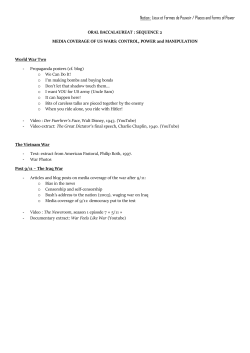
CENG 3210 Separation Processes
CENG 3210 Separation Processes Tutorial 10 solution The ternary equilibrium data of trichloroethane (C)-acetone (A)-water (B) at 25oC, 1 atm, are given in the following table. Water phase (mass fraction) Trichloroethane phase (mass fraction) Acetone (xA) Water (xB) Trichloroethane Acetone (xC) (yA) Water (yB) Trichloroethane (yC) 0 0.9956 0.0044 0 0.0011 0.9989 0.0596 0.9352 0.0052 0.0875 0.0032 0.9093 0.1000 0.894 0.0060 0.1500 0.0060 0.8440 0.1397 0.8535 0.0068 0.2078 0.0090 0.7832 0.1905 0.8016 0.0079 0.2766 0.0133 0.7101 0.2763 0.7133 0.0104 0.3939 0.0240 0.5821 0.3573 0.6267 0.0160 0.4821 0.0426 0.4753 0.4605 0.5020 0.0375 0.5740 0.0890 0.3370 0.58 0.22 0.2 0.58 0.22 0.2 (1) Plot the equilibrium curve on the right-angle triangle diagram. (2) Draw the tie lines (3) Construct the conjugate line. In a single stage extractor, pure trichloroethane solvent is used to extract acetone from an acetonewater solution containing 54 kg acetone and 66 kg water. It is required to reduce the acetone content in the raffinate to below 10% (mass %), calculate (4) The amount of trichloroethane required. (5) The mass in the extract phase and its acetone mass fraction 1 (1) equilibrium curve C 1.0 0.8 x C, y C 0.6 0.4 0.2 0.0 B 0.0 (2) 0.2 0.4 0.6 xA, yA tie lines 2 0.8 1.0 A (3) conjugate line (4) In the feed, F = 54 + 66 = 120 kg, xAF = 54/120 = 0.45, xBF = 66/120 = 0.55, xCF = 0. This is point F in the figure. The entering solvent is pure trichloroethane at the corner C. Draw line FC. In the raffinate (x) phase, xA = 0.1. Locate point R at the equilibrium boundary curve at xA = 0.1, xC = 0.006. Draw a vertical line from R to intersect the conjugate 3 line at H, then draw a horizontal line from H to intersect the boundary curve at E, which is the composition of the extract phase, yA = 0.15, yC = 0.844. Link line RE to intersect line FC at point M, which is the composition of the mixture of extract and raffinate phases, xAM = 0.14. Let S be the solvent entering, yAS = 0 (pure solvent), from the material balance, we have F+S=M FxAF + SyAS = MxAM = (F+S)xAM 120(0.45) + 0 = (120 + S)(0.14) S = 266 kg Or using the lever rule, 𝑆= ̅̅̅̅̅ 𝑀𝐹 𝐹 ̅̅̅̅̅ 𝑀𝐶 = 120 4 15.2 6.85 = 266 𝑘𝑔 C 1.0 E H 0.8 M x C, y C 0.6 Conjugate line 0.4 0.2 A 0.0 B 0.0 R 0.2 0.4 F 0.6 0.8 1.0 xA, yA (5) M = F + S = 120 + 266 = 386 kg From part (4) we have known that acetone concentrations are yA = 0.15 in the extract phase and xA = 0.1 in the raffinate phase. Let E be the amount of the extract phase and R the amount of the raffinate phase. From the material balance, we have E + R = M = 386 kg EyA + RxA = MxAM E(0.15) + R(0.1) = 386(0.14) Solving to obtain E = 77 kg R = 309 kg 5
© Copyright 2025








![HA[ ]A][OH[ ]HA[ ]A][H[ :]B[ ] OH][ BH[](http://cdn1.abcdocz.com/store/data/000740458_1-706cb02e45d03b91db108f66801d8dd4-250x500.png)


